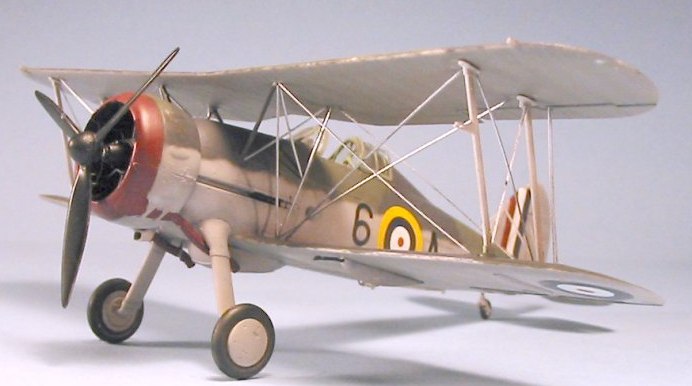
|
KIT: |
Roden 1/48 Sea Gladiator |
|
KIT # |
? |
|
PRICE: |
$24.95 |
|
DECALS: |
6 aircraft incl 2 from Malta and 2 from HMS Eagle |
|
REVIEWER: |
|
|
NOTES: |

|
HISTORY |
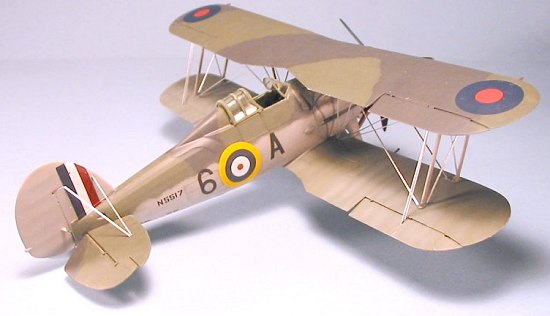 While
there were designs in progress, with war clouds gathering in late 1938
when the Nimrod was thoroughly obsolete, the Navy urgently needed a new
fighter with at least a chance of holding its own over the ocean, where
the likely opponent would not be operating single-engine fighters. The
Admiralty was able to obtain sixty aircraft on the RAF's Gladiator II
contract (N5500-N5549 and N5565-N5574) on May 24, 1939 as Sea Gladiators.
Prior to this, 14 Gladiator IIs were fitted with arrester hooks, with
others utilized for familiarization training and were not intended for
operational use aboard carriers. Both the Watts wooden two-blade prop
and the Fairey-Reed metal prop were tested; while it was concluded that
the Watts propeller was much superior for carrier operations, it was
decided to standardize on the Fairey-Reed prop for the Sea Gladiators
under construction. In the end, the only difference between the Sea
Gladiator and the Gladiator II was the installation of an A-frame
arrestor hook below the rear fuselage ahead of the tail wheel, and dinghy
carried in a container between the landing gear legs.
While
there were designs in progress, with war clouds gathering in late 1938
when the Nimrod was thoroughly obsolete, the Navy urgently needed a new
fighter with at least a chance of holding its own over the ocean, where
the likely opponent would not be operating single-engine fighters. The
Admiralty was able to obtain sixty aircraft on the RAF's Gladiator II
contract (N5500-N5549 and N5565-N5574) on May 24, 1939 as Sea Gladiators.
Prior to this, 14 Gladiator IIs were fitted with arrester hooks, with
others utilized for familiarization training and were not intended for
operational use aboard carriers. Both the Watts wooden two-blade prop
and the Fairey-Reed metal prop were tested; while it was concluded that
the Watts propeller was much superior for carrier operations, it was
decided to standardize on the Fairey-Reed prop for the Sea Gladiators
under construction. In the end, the only difference between the Sea
Gladiator and the Gladiator II was the installation of an A-frame
arrestor hook below the rear fuselage ahead of the tail wheel, and dinghy
carried in a container between the landing gear legs.
The first Sea Gladiators went to 801 Squadron aboard HMS "Courageous" at the end of May, 1939, with all the Sea Gladiators delivered by the end of 1939 following the outbreak of war on September 3.
The Sea Gladiator first entered combat on April 22, 1940 during the German invasion of Norway, when Sea Gladiators of 804 Squadron aboard HMS "Glorious" intercepted several Heinkel bombers and shot down three while Gladiator IIs of 263 Squadron, RAF, were being ferried to Lake Lesja.
By 1940, when Italy entered the war, the Royal Navy and the Fleet Air Arm were stretched thin. While the story of the SEa Gladiators of the Hal Far flight at Malta have received much recognition for their role as the sole air defense of the island during the opening stages of the air war aimed at reducing it, there was another flight of Sea Gladiators operational in the Mediterranean which also provided sterling service.
At the outbreak of war in the Mediterranean, HMS Eagle - the sole fleet carrier in the Med at the time - did not carry a fighter squadron. Four Sea Gladiators - N5512, N5513, N5517 and N5567 - were hurriedly withdrawn from storage on Malta, assembled, and taken aboard the carrier on June 16, 1940. The Eagle Fighter Flight was commanded by CDR Charles Keighly-Peach, who managed to train several Fairey Swordfish pilots in fighter tactics.
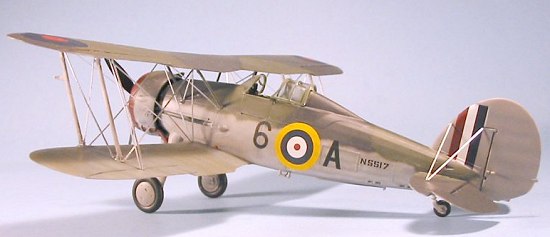 Almost one month later, on July
11, 1940, the British Mediterranean Fleet was spotted by an Italian
flying boat. Though the Sea Gladiators intercepted and made contact,
their initial attacks were unsuccessful. That afternoon, Keighly-Peach -
known as K-P to his men - was on patrol over the fleet in N5517/6-A, in
company with Lt. Kenneth Keith in N5513 when he spotted five S.79s below
him, heading toward the ships. The two Sea Gladiators dove vertically on
the Italian bombers, with K-P heading for the lead plane as he closed to
less than 50 yards before opening fire. After three attacks, the Italian
leader caught fire and dropped back, before entering a spin and impacting
the sea with no survivors. K-P was wounded in the thigh during the
attack. The two Sea Gladiators had to break off their attacks on the
other S.79s as the fleet opened fire.
Almost one month later, on July
11, 1940, the British Mediterranean Fleet was spotted by an Italian
flying boat. Though the Sea Gladiators intercepted and made contact,
their initial attacks were unsuccessful. That afternoon, Keighly-Peach -
known as K-P to his men - was on patrol over the fleet in N5517/6-A, in
company with Lt. Kenneth Keith in N5513 when he spotted five S.79s below
him, heading toward the ships. The two Sea Gladiators dove vertically on
the Italian bombers, with K-P heading for the lead plane as he closed to
less than 50 yards before opening fire. After three attacks, the Italian
leader caught fire and dropped back, before entering a spin and impacting
the sea with no survivors. K-P was wounded in the thigh during the
attack. The two Sea Gladiators had to break off their attacks on the
other S.79s as the fleet opened fire.
On July 14, K-P was launched at dawn south of Crete. At 0750, he spotted a lone S.79 and made three attacks from out of the sun, with the result that this Sparviero also caught fire and spun into the ocean. Three hours later, in company again with Lt. Keith, the two Sea Gladiators spotted three more S.79s approaching the fleet. Keith opened fire on the left-hand Sparviero, joined by K-P, and the unfortunate Italian crashed into the sea from their combined fire. A few hours later, Keith was launched alone to intercept a formation of S.81s from 200 Squadriglia; after a beam attack and a stern chase, he sent one of these into the sea, to mark the end of a very successful day for the flight. On July 29th, K-P intercepted another formation of S.79s and sent his third Sparviero into the sea.
The next month, Eagle's Sea Gladiators were sent ashore to Sidi Barani to provide fleet defense with RAF Gladiators when the fleet bombarded the Libyan port of Bardia. On August 17, separated from his flight over the British fleet, Keighly-Peach attacked two separate S.79s, forcing them to break off their attacks though not shooting them down. Lt. Keith bagged another S.79 in company with a Gladiator from 112 Squadron RAF. Overall, the Italians lost 4 bombers destroyed and several damaged in this action.
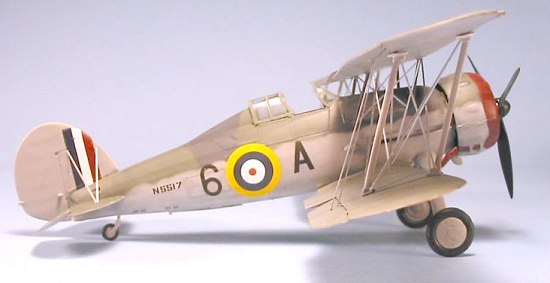 Again off Crete on August 31,
K-P was launched with Lt. Oliphant to intercept a shadower, which turned
out to be a Cant Z.506B at 6,000 feet. K-P shot the floatplane down,
with the crew escaping by parachute. It was his last victory, making him
the leading FAA fighter pilot on the Sea Gladiator; he was awarded the
DSO the following month for his leadership of the Eagle Fighter Flight
and his achievements over the fleet.
Again off Crete on August 31,
K-P was launched with Lt. Oliphant to intercept a shadower, which turned
out to be a Cant Z.506B at 6,000 feet. K-P shot the floatplane down,
with the crew escaping by parachute. It was his last victory, making him
the leading FAA fighter pilot on the Sea Gladiator; he was awarded the
DSO the following month for his leadership of the Eagle Fighter Flight
and his achievements over the fleet.
Also in early September, HMS "Illustrious" arrived in the Mediterranean with a full compliment of Fulmars in 806 Squadron, and "Eagle's" foursome were no longer the only Fleet Air Arm fighters in the region; they were then designated 813 Squadron. On 6 November, 806 Squadron took aboard three Sea Gladiators from 813 Squadron, as the carrier was tasked with covering two convoys to Malta. On November 8, 1940, Lt. Roger Nichols in N5549 and Sub. Lt. Jack Sewell in N5513 destroyed a Cant Z.501, to record the last victory of the Sea Gladiator at sea.
On January 10, 1941, following arrival of "Illustrious" at Malta with another convoy, the three Sea Gladiators were off-loaded and turned over to 261 Squadron on the island, which was down to four effective fighters after heavy attacks. On January 24, 1941, Sub. Lt. Sewell spotted a German Ju-88 diving toward Hal Far, and shot it down. It was Sewell's fifth of an eventual 6 victories scored with Sea Gladiators and Fulmars, and also the last victory by a Sea Gladiator over Malta.
|
THE KIT |
If you have seen the Roden Gladiator I, you know what awaits in the box here. There is one additional sprue with the Fairey-Reed propeller, a different air intake for the engine, and the dinghy fairing.
The decals are different than
those provided in the previous kit, being prewar red and blue. I am not
certain of this for a fact, but I think these colors are too bright for
wartime Sea Gladiators, and I eventually used kit decals remaining from
one of my other Gladiator kits for the national markings. Decals cover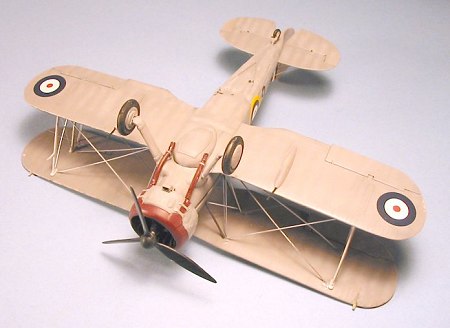 two Sea Gladiators from 804 Squadron aboard HMS "Glorious" during the
Norwegian campaign, two from the Eagle Fighter Flight, two from the Hal
Far fighter flight on Malta including the famous N5519, and an all-black
Sea Gladiator used as a night fighter by the RAF. I later discovered
that these kit decals were not properly sized, at least as regards the
tail fin markings for N5517 flown by Cdr. Keighly-Peach, so was very glad
indeed to have the remaining decals from the other kits.
two Sea Gladiators from 804 Squadron aboard HMS "Glorious" during the
Norwegian campaign, two from the Eagle Fighter Flight, two from the Hal
Far fighter flight on Malta including the famous N5519, and an all-black
Sea Gladiator used as a night fighter by the RAF. I later discovered
that these kit decals were not properly sized, at least as regards the
tail fin markings for N5517 flown by Cdr. Keighly-Peach, so was very glad
indeed to have the remaining decals from the other kits.
|
CONSTRUCTION |
Perhaps practice does indeed make perfect, but as the third Roden Gladiator I have built, this model went together easily. I used the kit engine and cowling on this one, instead of the parts from the old Inpact kit, and found that if the modeler carefully assembles the engine, it will fit inside the cowling with no problem.
I also posed all the control surfaces in "active" positions, for looks. Remember when you do this to position the control stick in the cockpit so it is in the right position for what the controls are doing. (In my case, the stick is posed leaning forward and to the left a bit, with the rudder bar kicked to the right.)
Other than that, construction was as outlined in my previous article on the Gladiator.
|
CAMOUFLAGE & MARKINGS |
Painting:
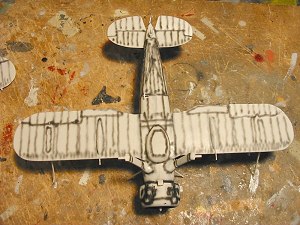 I have to agree with my friend
Mark Gran that the Sea Gladiator looks better in camouflage than do the
RAF Gladiators.
I have to agree with my friend
Mark Gran that the Sea Gladiator looks better in camouflage than do the
RAF Gladiators.
After pre-shading the model, I
painted the upper surfaces of the lower wing, in Light Slate Grey and Sea
Grey - these being created by lightening some Tamiya RLM Grey for the
Light Slate Grey and using Tamiya Neutral Grey for the Sea Grey; this was
part of the "shadow shading" scheme used on Sea Gladiators. Once these
were dry, I masked off these areas, and proceeded to paint the model with
Tamiya Sky Grey for the lower surface "Sky Grey" color, Tamiya RLM Grey
for "Slate Grey," and
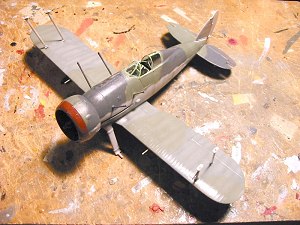 Tamiya Dark Sea Grey for "Dark Sea Grey." The kit
instructions provide camouflage patterns for the various aircraft. I
noted in comparing these drawings with photos in the Squadron In-Action
Gladiator book and the Osprey "Gladiator Aces" book of Keighly-Peach's
N5517 that the kit instructions showed the upper color on the fuselage
coming down too far, and followed the photos.
Tamiya Dark Sea Grey for "Dark Sea Grey." The kit
instructions provide camouflage patterns for the various aircraft. I
noted in comparing these drawings with photos in the Squadron In-Action
Gladiator book and the Osprey "Gladiator Aces" book of Keighly-Peach's
N5517 that the kit instructions showed the upper color on the fuselage
coming down too far, and followed the photos.
Once everything was painted, I unmasked the lower wings and gave the model a coat of Future.
Decals:
I used national insignias from the earlier Gladiator I kit, and used the Sea Gladiator kit decals for the individual markings of K-P's airplane, N5517/6-A. These decals from Roden are not that good, but do eventually go down under repeated assault by Micro-Sol and Micro-Set.
|
FINAL CONSTRUCTION |
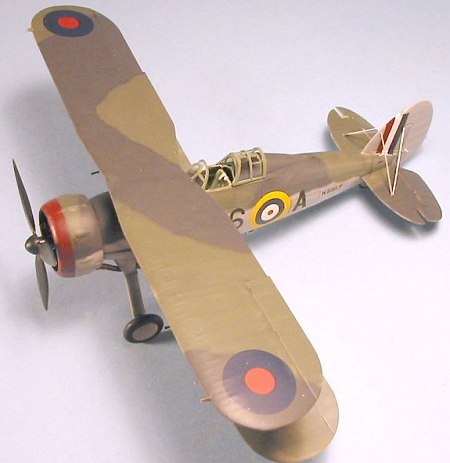 When the decals had set, I washed
the model to get rid of dried setting solution, then gave it another
overall coat of Future. I followed that with three coats of thinned Dullcote.
When the decals had set, I washed
the model to get rid of dried setting solution, then gave it another
overall coat of Future. I followed that with three coats of thinned Dullcote.
Attaching the upper wing is "fiddly," but again, experience on the two previous models proved helpful and it was attached.
I rigged the model using Evergreen .010 x .020 strip, painted aluminum, to simulate the "rafwires" used on the Gladiator. This plastic strip is the exact same size as the photo-etch rigging in the Tamiya Swordfish. If you do this, I suggest you attach one end, get the strip positioned right, then put glue on the other end - otherwise it is easy with this very light material to get "bent rigging."
|
CONCLUSIONS |
The Sea Gladiator is a historically-significant airplane, and a "must have" for anyone who collects the aircraft of the British Fleet Air Arm. The Roden kit creates an excellent model that is fully accurate in shape and outline.
Thanks to Roden for the review kit.
If you would like your product reviewed fairly and quickly by a site that has over 200,000 visitors a month, please contact me or see other details in the Note to Contributors.